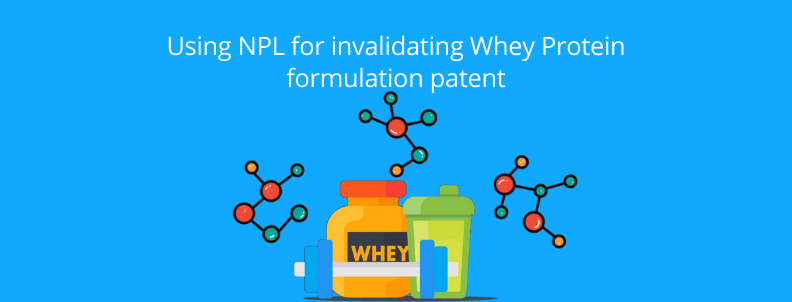Have you ever faced a situation where you are trying to invalidate a formulation patent and end up not having even a single prior art disclosing the exact same proportions of ingredients?
Despite a thorough search, chances are this happens with the best of us. Searching prior art for formulation patents is a whole different ball game, as even a small change in any one of the excipients can have unexpected effects on the stability of the entire formulation and its effects.
For example – in antibody formulation, the tiniest change in excipient could affect protein aggregation, viscosity, and other factors of the whole composition. Thus it becomes important to find the same combination of ingredients in the exact proportions in the prior art.
In our experience, we have found that this kind of search involving formulation patents requires something more than the normal invalidation searches. It is necessary to pursue an investigative approach for invalidating formulation patents.
What do I mean? Let me explain albeit with the help of an example.
How do we approach invalidation searches for formulation patents?
Recently, we were contacted by Brian, a Senior Patent attorney in one of the leading law firms in the US. His client – a multinational company in a Pharma domain – was facing litigation from one of their competitors’ patents.
This patent was related to nutraceutical composition containing whey protein concentration in the range of 0-1 %, which provides energy in the range of 0 – 2 kcal/mL. An important point to note here is even a small change in the range would change the therapeutic effect of the complete composition. This was an important case for Brian and his client with millions at stake, and Brian wanted us to do a litigation grade search to invalidate this patent.
Once we had the approval from Brian, we started the search adopting conventional approaches like keyword-based and class-based searching on various databases like Derwent, Patsnap, Patbase, etc.
We also checked tables in each of these patents because sometimes the formulation information is represented in a table (image form), so we scrutinized each and every PDF of the documents to go through the tables manually to find the required quantity. This is not as simple as it sounds. We also had to employ unit conversion, as sometimes in documents, information is specified in different units. The idea was to correlate the numbers in the current patent with the desired ones specified in the subject patent by applying unit conversions. However, despite an extensive search, we did not find even a single document disclosing the exact range of whey as required by the subject patent.
After going through a number of documents, we finally got one US publication (US20050153030A1) disclosing a nutraceutical composition containing cow milk protein in the 0.5 – 5% range. However, the exact proportion of whey was not specified there either.
Now, normally in this situation, people would give up and move on to check any other leads. If they don’t end up finding something, the “No references found” report is inevitable. However, this is where we shine.
This was a difficult lead to pursue, but a good one at the same time. Now, it is a well-known fact that milk is made up of 2 proteins – Casein and Whey. If we could find any supporting documentation to correlate cow milk protein percentage with whey protein percentage, it would qualify as good prior art.
We next started our non-patent literature search, going through piles of research papers, journals, and other publications. After about a considerable amount of time spent sifting through literature, we finally found what we were looking for. The document – A study of Whey proteins from the Milk of various animals, disclosed the quantity of whey protein in different varieties of milk, and in that document, we found the exact same proportion of whey.

This could serve as bang on art for this feature.
Now, coming to the other claim element (i.e. energy content), the documents do not explicitly mention the energy provided by the compositions. We went to the basics and applied basic biochemical knowledge, that carbohydrates & protein provide 4 calories per gram, and fat provides 9 calories per gram.
Implementing this, we mathematically calculated the energy content in this case as follows:
We found a result that disclosed protein content (Whey protein + lactalbumin) is 11100 g/100L. So we applied a simple mathematical formula, that protein provides 4 calories per gram. Then 11100 grams of protein provides 44400 calories/100 L, or I can say that 444 kcal/L or .444 kcal/ml (required one).
Additionally, composition comprises milk flavor and vitamins but their energy contribution seems to be very less in this composition. Hence, their contribution can be easily ignored.
When we shared our findings with Brian. Brian shared this feedback with us- “I was initially skeptical if there would be any good Tier-I references for this project, but you guys literally gave your best. Good Job!”
Concluding Notes
Invalidating Formulation patents comes with the challenge of finding prior art describing exactly the same composition in the same proportion. In cases like this, it is important not to rely on just keyword searching, but adopt various tactics and strategies that can deem effective results and help us fine-tune our methodologies/approach to search.
Below are few cases where above mentioned strategies can help:
- 1-21-cv-00871 (DDE) Exelixis, Inc. v. Teva Pharmaceutical Industries Ltd. et al
- 1-21-cv-00549 (DDE) CMP Development LLC v. Amneal Pharmaceuticals LLC
- Endo Ventures Limited et al v. Baxter Healthcare Corp. 1:21-cv-01186
- NEXUS PHARMACEUTICALS, INC. v. NEVAKAR, INC. et al 1:21-cv-15524
- 1-21-cv-00425 (DDE) Astellas Pharma Inc. et al v. Aurobindo Pharma Ltd. et al
- 1-21-cv-00612 (DDE) Mayne Pharma LLC v. Perrigo Israel Pharmaceuticals Ltd. et al
- 1-21-cv-01019 (DDE) Vertex Pharmaceuticals Incorporated v. Lupin Ltd. et al
- VYNE Therapeutics Inc. v. Padagis Israel Pharmaceuticals, Ltd.
Having worked on various such projects over the years, we have accumulated a huge arsenal of strategies that help us perform efficient searches. We have covered some of these strategies and resources we use for prior art searches here.
Found this interesting and want to work with us? Let’s have a chat:

Authored by: Divya Goyal, Pharma Team










